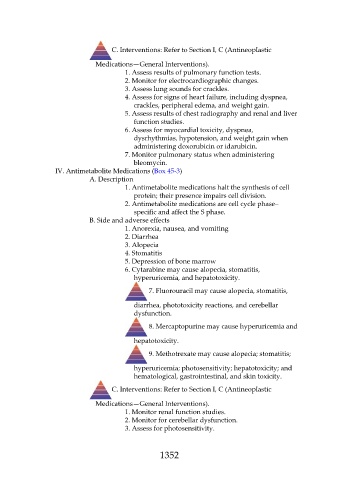Page 1352 - Saunders Comprehensive Review For NCLEX-RN
P. 1352
C. Interventions: Refer to Section I, C (Antineoplastic
Medications—General Interventions).
1. Assess results of pulmonary function tests.
2. Monitor for electrocardiographic changes.
3. Assess lung sounds for crackles.
4. Assess for signs of heart failure, including dyspnea,
crackles, peripheral edema, and weight gain.
5. Assess results of chest radiography and renal and liver
function studies.
6. Assess for myocardial toxicity, dyspnea,
dysrhythmias, hypotension, and weight gain when
administering doxorubicin or idarubicin.
7. Monitor pulmonary status when administering
bleomycin.
IV. Antimetabolite Medications (Box 45-3)
A. Description
1. Antimetabolite medications halt the synthesis of cell
protein; their presence impairs cell division.
2. Antimetabolite medications are cell cycle phase–
specific and affect the S phase.
B. Side and adverse effects
1. Anorexia, nausea, and vomiting
2. Diarrhea
3. Alopecia
4. Stomatitis
5. Depression of bone marrow
6. Cytarabine may cause alopecia, stomatitis,
hyperuricemia, and hepatotoxicity.
7. Fluorouracil may cause alopecia, stomatitis,
diarrhea, phototoxicity reactions, and cerebellar
dysfunction.
8. Mercaptopurine may cause hyperuricemia and
hepatotoxicity.
9. Methotrexate may cause alopecia; stomatitis;
hyperuricemia; photosensitivity; hepatotoxicity; and
hematological, gastrointestinal, and skin toxicity.
C. Interventions: Refer to Section I, C (Antineoplastic
Medications—General Interventions).
1. Monitor renal function studies.
2. Monitor for cerebellar dysfunction.
3. Assess for photosensitivity.
1352

